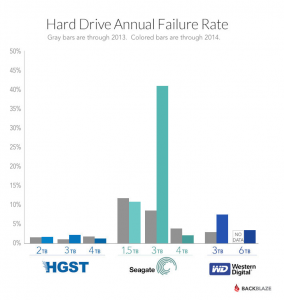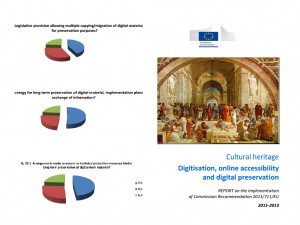In my previous blog post I mentioned that I try to devote some time every week to reading articles, conference roundups, and anything else I can find that is relevant to the field of digital preservation at large. This time around I thought it would be fun to elaborate on this point by digging through my browser history to look at some of the articles and resources that I’ve read over the past week or so. Partially inspired by Steven Soderbergh’s 2014 Media Diet*, here is a glance at what I’ve been reading:
*If you haven’t read this yet I strongly recommend doing so at your earliest convenience. Even if you aren’t Steven Soderbergh’s biggest fan, let his media diet serve as, if nothing else, a motivational tool to remind you that you have the same number of hours in your day as he does.
Blackblaze’s annual hard drive failure report. Although this report is far from scientific, it’s a fun one nevertheless. I sent this report the day it was released to a couple of my colleagues at Carnegie Hall who are responsible for purchasing commercial hard drives for their departments. Their response was something along the lines of “this makes me nauseous”.

A graphic from the Blackblaze report illustrating the annual failure rate of hard drive failures based on model and size.
Reference Model for an Open Archival Information System. Re-read parts of section 2.1 on the OAIS Environment and section 3 on OAIS Responsibilities. Needed to reference the definitions of “Designated Community” for a draft of our Access Policy that I’ve been working on this week.
Creating and Archiving Born Digital Video. Back in December the Federal Agencies Digitization Guidelines Initiative published four reports examining aspects of current practice for creating and archiving born digital video. December was a busy month for me so I’m only getting around to reading these reports now. I’m only on Part I as of this week, but so far I’m finding them to be a hugely relevant and valuable resource. I highly recommend checking them out.

European Commission’s Report on Digitisation, Online Accessibility and Digital Preservation of Cultural Material.
European Commission’s Report on Digitisation, Online Accessibility and Digital Preservation of Cultural Material. This report was put together based on a set of national reports submitted at the end of 2013 and beginning of 2014. It’s chock full of statistics relating to any number of cultural heritage issues, but I skipped down to the section on Digital Preservation (page 51 for those of you following along at home). I liked the way that this report detailed the long-term preservation strategies and action plans for each of the EU member countries, and found myself wishing that there was a comparable document for stateside cultural heritage programs.
Disaster Preparedness Plans. I’m putting the finishing touches on a disaster preparedness plan for the Carnegie Hall Archives so lately I’ve consulted a variety of different plans, tools, and checklists to determine which features will make the final cut. Frankly, I’ve been bowled over by the sheer number of resources out there designed to assist with this task. This week alone I’ve read and compared upwards of a dozen plans. While almost all of the plans offer some useful to takeaways, the one I have returned to most frequently has been the Paul V. Galvin Library’s Disaster Plan Manual and Digital Emergency Preparedness and Recovery Plan. I like this plan in part because of its focus on digital disaster preparedness. It’s also succinct and clearly written. Another resource worth mentioning her is the workbook hosted by NYU Libraries, which has a lot of useful information about really left-field topics like what to do in the event of a bomb scare or terrorist attack. (The more you know, I suppose…)
Some weeks this list looks a lot longer or shorter, depending on what else I have on my plate. But even when I’m swamped with other things that need doing, I still consider reading to be an essential part of my job. In a field driven by rapidly changing technologies, tools, and workflows, being part of the conversation is crucial to your success. Fortunately, it’s easier now than ever to stay in the loop and find relevant material. By way of concluding this post, here are a few places to get started if you’re looking to build out your reading list:
- The Signal – the Library of Congress’ blog dedicated to Digital Preservation.
- Kara Van Malssen’s syllabi for the Digital Preservation course she teaches at NYU’s Moving Image Archiving and Preservation program, which can be found here.
- Twitter. If you’re new to this site and/or are unsure about where to begin, try searching for #digipres or #digitalpreservation and see where that takes you.
- The Digital Preservation Management Workshop and Tutorial website is a fantastic resource, particularly if you’re new to the field.
- Take a gander at D-Lib Magazine’s archives; there’s a lot of good stuff in there.
- The Open Preservation Foundation is a great resource for finding out about conferences that are happening and reports that are being released.
- Google alerts. Pick keywords relevant to the project you’re working on, the problem you’re trying to solve, or the subject you’re interested in learning more about. I usually have a few of these set up at any given point in time that usually include keywords like “digital preservation”, “digital asset management” “preservation sustainability” and “born-digital preservation”.

